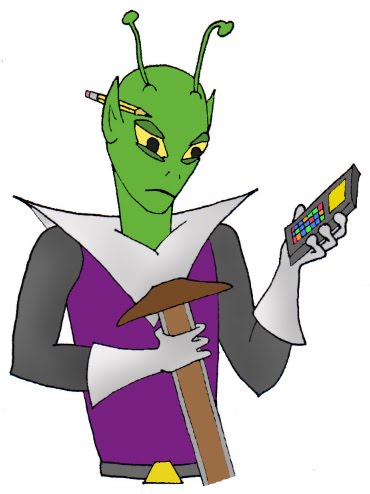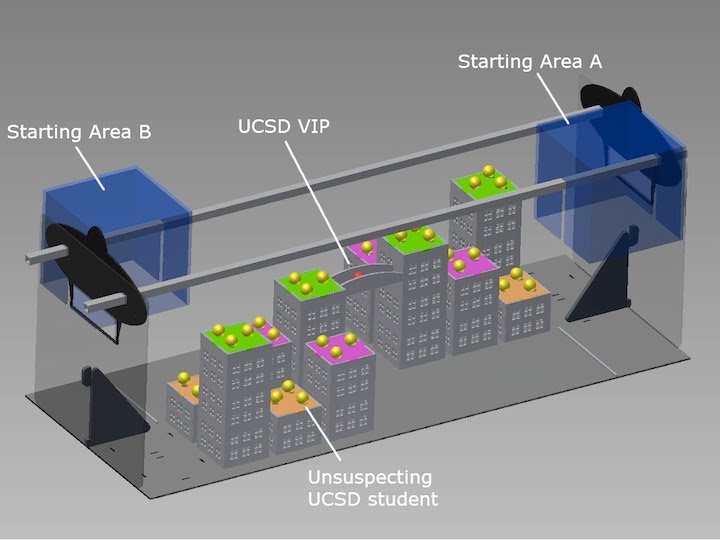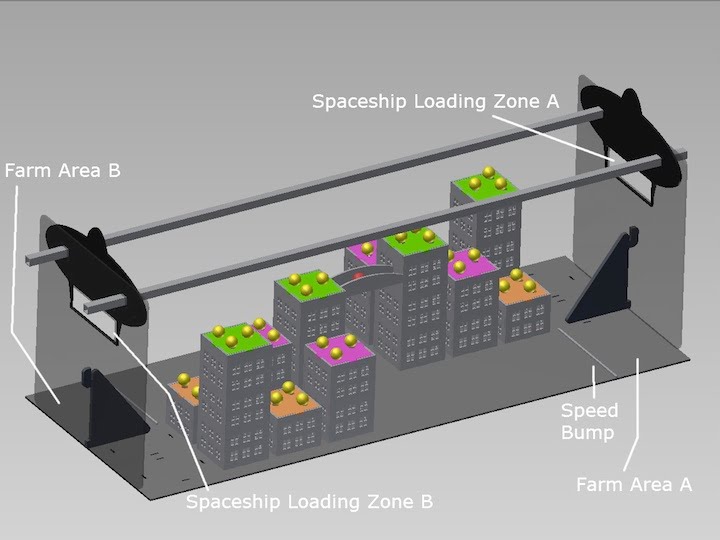Alien Engineering Robot Contest
Alien Engineer with a T Square as drawn by MAE3 tutor Brian Miller
Robot Contest Results from December 7, 2011
Contest DescriptionAlien engineers have a hard job. Not only do they need to ensure that their spaceships work reliably, but they have to design apparatus to abduct unsuspecting humans and perform important research operations on them. A recent scouting expedition has intercepted an earthling transmission rating the coolest educational institutions on the planet. One has been noted to have exceptional specimens for our research, UC San Diego. Your task will be to design a machine for your alien brethren to help abduct UCSD students and their leaders and transport them back to your mothership.
Your commander has pitted two alien engineering teams against each other to see whose design can abduct more human specimens. Your alien design skills will be rated in an introductory design course, MAE3, where a model has been created of the expected operating conditions at UCSD. In this contest, your mothership will land on campus in a designated Starting Area (A or B), and your goal is to abduct as many students as possible. Unsuspecting UCSD students are scattered around campus, and a VIP has been spotted in a central location. Based upon your early physics coursework and study of spherical cows, you have decided to model humans as spheres. A schematic of your operating field is shown in the figure below.
Contest Playing Field Overview Your design team will be arbitrarily assigned to either Starting Area A or B. Your vehicle will start suspended on a horizontal transport beam, but may maneuver to any part of the playing field during the 60 second contest period. Important details are shown in the figure below. Adjacent to your starting area is your mothership with a designated loading zone. The best way to secure wily humans is to transfer them through this loading zone. An alternate abduction method is to transport the humans to a farm area where they will be sustained (with simulated cafeteria food rations) and them beamed up to the spaceship at a later date. An advanced team has built a speed bump adjacent to the farm area to prevent specimens from wandering away.
Playing Field Details Contest Scoring
- UCSD students placed in or above the farm area adjacent to your starting area score 1 point.
- UCSD students transferred through your mothership's loading zone score 3 points.
- Placing the UCSD VIP in or above the farm area earns 5 points, and transferring the VIP through your mothership's loading zone scores 15 points.
- Moving the VIP to your starting side of the playing field will serve as a tie breaker.
- Students can be abducted from any location on campus, and only the final location of the students at the end of the contest will contribute to points scored.
Key Rules
A complete list of rules is provided at the end of this
document, and any clarifications to the rules will be posted at the end of this
list throughout the quarter. However, some key rules are:
- The robot starting location is defined by a test box. This test box is approximately 12”x12”x12" and horizontally centered around the transport beam, with the utmost height being 4" above the beam. The starting area is offset by 0.25" from the mothership and the robot cannot touch the mothership in its starting location, but can touch the mothership later in the contest.
- Scoring will take place after the 1-minute contest, and all
parts have stopped moving.
- Robot setup time on the contest table cannot exceed 2
minutes.
- Only the final location of the playing pieces will count, regardless
of what robot touched the pieces.
- Manufacturing variations will exist between playing
fields. It is the team's
responsibility to design a robot that will work on all contest tables.
- The robots will be arbitrarily assigned to start in either
the right or left starting areas.
- Each robot must only be built out of kit parts described in
a later section of this document.
- Robots can be made only from the kit parts listed later in this document.
- Robots must be built in the Design Studio only using Design
Studio tools.
- The disassembled robot must be able to fit in the team's locker,
where it must be stored.
- Robots may be designed to interact. However, it is not in
the spirit of the competition to intentionally damage another machine and no
part of the kit may be used in a manner that is intended to cause harm. Any device
which is designed to chop, break, or penetrate another machine will not be
allowed to compete. If you think your machine may be at risk for violating this
rule, ask early before you build it! Applying forces onto an opposing team’s
robot that are large enough to break plastic pasts, while the opposing robot is
in its starting area, will be deemed to be intentional harm to an opponent and
can lead to disqualification. However, blocking other robots or pushing other
robots while attempting to score will generally be considered legal.
- Robots will compete in a head-to-head competition. However, operation of
the robot without an opponent will be an important part of the robot grade.
Electrical Power
The robots must be powered solely from electrical power transferred through the power cord, and from potential energy stored in the robot at the start of the contest. The kit includes 2 geared DC motors, 3 non-geared DC motors, and one
solenoid. Electrical power will be provided from a power supply with a maximum
of 5VDC output. The power will be controlled by the following switches:
Two Fixed 5 Volts DC switches Two Variable Voltage switches (0 to 5VDC) with a user controlled knob to adjust the voltage.
Each switch is Double Pole Double Throw (DPDT) switches, which can operate a DC motor in either direction. Note the kit contains five DC motors and one solenoid, but only four user controlled switches. More than one electrical device can be connected to a single switch, but the voltage may drop if a large current draw is placed on the power supply. Use of motors, solenoids, and switches will be covered in lecture and is described in the course pack. Review the Power Supply and Multimeter Use carefully. Issues with the electrical power often occur with the Variable Voltage switches, since the maximum current output is less in these switches. The non-geared motors draw high current and startup problems may occur if multiple non-geared motors with high loads are tied to the variable voltage source!
Each machine must be constructed solely from materials
provided in the Kit Part list. Some key points on these guideliens are: - Clear 0.25" acrylic is for testing purposes. If a team uses clear acrylic or acrylic they purchased, they must demonstrate to their tutor that the could rebuild their robot from the original kit parts.
- The wire and string are serve your self, but are limited in length as noted.
- The paper cover on the acrylic parts is not to be used as a separate part. If it is detached form the acrylic it must be discarded.
In addition to the kit parts listed in the table, the
following items may be included in the machine:
- Nuts, bolts, and washers included in the Design Studio bin.
These include bolts from size 2 to size 10, and metric screws for mounting the
motors.
- Only take nuts and bolts from the bin as you need them, and
search through the spare bolt bin before taking more (we went through $1,500 in
fasteners last year!)
- Fasteners can be used only for fastening purposes, and thus
must fasten at least two other parts together.
- Adhesives; including hot melt glue,
and acrylic adhesive.
- Tape used ONLY for electrical
insulation
- Lubricants used only to reduce
friction within one's machine (not on the contest table).
- Nonfunctional decorations.
Replacement Material Policy We have some extra material that can be used for experimentation. This material will be made available in the lab scrap bins. In addition each section tutor has access to a limited amount of replacement material for their section. If you need replacement parts, contact your tutor. Some replacement of "mistakes" made to kit parts will be available, but supplies are limited, and replacement is not guaranteed.
Contest Event Description The contest will be held during the MAE finals period and will be open to the public. The contest will be held in a single elimination fashion (like a tennis tournament). During the lab period of the last week of classes, each section will hold a section-wide contest. The results of this contest will be used to seed the placement of the final contest. Thus teams that perform better during their section contest will have statistically easier contests in the early rounds. Since the number of teams in the class will not be exactly a power of 2, the higher seeded teams may get a "buy" during the first round. If necessary "wild card" teams will be selected to have a second chance in the contest, to ensure that all pyramid spots are filled. Performance in the contest depends on numerous factors that do not relate to engineering quality of the robot, including driving skill and luck! The grade for the project will not be adversely affected by poor performance in the contest, but will be based upon: - Performance of the machine without an opponent. A video record of the robot performance at its best should be the team's oral presentation.
- Effective communication of the design (orally and in final reports).
- Documentation of the design process and justification of decisions made.
- Analysis of machine performance in the robot reports.
- Following good design practices.
A trophy will be presented to each member of the winning teams, and a number of machines will be selected for display in the Design Studio. Team members must work out among themselves who will keep the final machine (after their display period). Teams will post presentations and video of their robot on the class web page, which they can cherish forever.
Expanded Rules List
Only the tools and machine equipment in the Design Studio
can be used to build the robot.
Energy Sources: The energy used by the devices in the
competition must come solely from:
Potential energy derived through a change in altitude of the center of
gravity of the machine
Potential energy achieved by the deformation of the springs provided by
the Kit
Electrical energy derived through the umbilical during the 60 seconds
when the power supply is energized.
Umbilical Cables: The electrical connections will made to a
single umbilical cord hung from above the table; one on each side of the table.
The umbilical cord cannot be touched during the contest, and there will be some
drag from the cable. Each machine must be designed to overcome this drag if
necessary for motion of the machine. If requested a TA can ensure that the
umbilical cable does not snag.
Detailed Rules
- Judges and/or instructors will disqualify any device that appears to be
a safety hazard.
- Any machine that has flying parts must notify opponents, and all
contestants must wear safety glasses during the machine operation.
- If
a projectile is used, for reasons of safety, it must have a frontal area
greater than 2 inch squared.
- Contestants will randomly be assigned to start on either side of the
playing field.
- A
maximum set-up time of 2 minutes will be allowed at the contest table.
- A
maximum of 1 minute will be allowed for removal of all parts of each machine
after each contest.
- Operators may interact with their machine during a contest only through
normal operation of the switch boxes (for example you cannot touch the machine
with one's hands during operation).
- It
is allowable to adjust the configuration of the machine between contests; for
example adjusting the configuration to the side of the playing field the
machine starts on.
- Each machine can only interact with the surface of the playing field and
objects on the playing field.
- The judges will wait until all the playing pieces have stopped moving before
determining the winner.
- Points will be awarded based upon the final location of the playing
pieces, regardless of which machine moved them.
- A
playing piece will be declared out-of-bounds if it is off the playing field.
- Damaging the playing field or the control boxes may result in
disqualification.
- Purposefully using the electrical cables for any purpose other than
transmitting electricity is not allowed.
- Gaining traction by use of adhesives, or by abrading or breaking the surface
of the playing field is not allowed.
- A
machine may not contaminate with lubricant or other substance the playing field
or an opponent's machine (internal lubrication of a machine is permissible).
- Kit materials may not be changed chemically. DC Motors may not be
rewound.
- The paper that is attached to the acrylic in the kit cannot be used as a
separate element in the machine. If any piece of paper is detached (even
partially) from the acrylic it must be discarded.
- The insulation must remain on the electrical wire in the kit except
where the wire end is attached to another component, and there up to 0.5” of
insulating can be removed.
- The clear acrylic 0.25 thick is for testing. If you include any of this
acrylic in your final machine, you must remove an equivalent amount of colored
acrylic that was used in making the part.
- Spare parts are available on a limited basis. Students should go to the
tutors of their section to receive replacements for parts broken. Student can
purchase replacement acrylic from upper campus machine shop or off campus (see
door of Chris Cassidy's office for sources)
- Machines may be designed to interact. However, it is not in the spirit
of the competition to intentionally damage another machine and no part of the
kit may be used in a manner that is intended to cause harm. Any device which is
designed to chop, break, or penetrate another machine will not be allowed to
compete. If you think your machine may be at risk for violating this rule, ask
early before you build it! (see rule clarifications)
- Machine advertisements and decorations must be of the nature that it
does not offend any other students or audience participants (use common
sense!).
- All rulings of the judges will be final.
|
 Updating... F2011_Abduction_field.zip (10977k) Chris Cassidy, Nov 22, 2011, 9:40 AM
|



